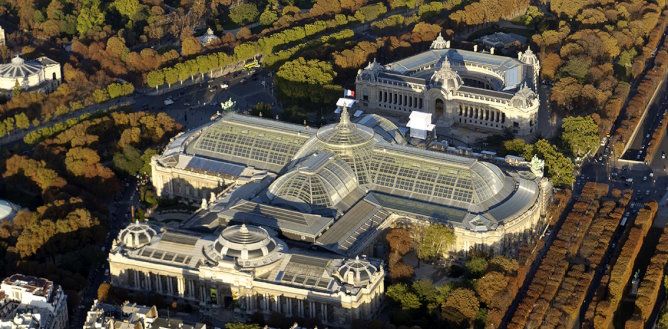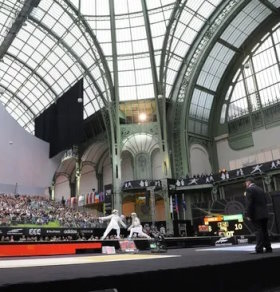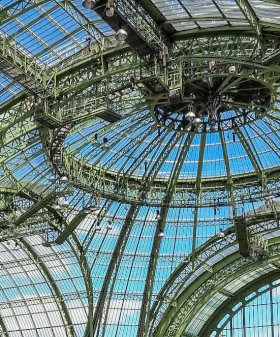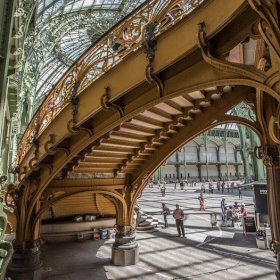Grand Palais in Paris. Facts and history

The Grand Palais was one of the most scenic venues of Paris Olympics 2024. It is also one of the greatest legacies ot the 1900 Universal Exhibition. Grand Palais will reopen to the public in 2025. Paris Olympics 2024. Top Paris monuments.
Grand Palais was an Olympic venue
The Grand Palais hosted the Fencing, Wheelchair fencing, Taekwondo, Para taekwondo competitions of the Olympics
The restored nave of the Grand Palais offered an improved visitor experience, with a capacity of 9,000 visitors and a brand new temperature regulation system. It was in this exceptional setting, under the emblematic 45 meter high glass roof, that the athletes competed, promising a majestic setting for sporting exploits.

Grand Palais was the Olympics fencing venue
Grand Palais facts
The Grand Palais was built in Paris between 1897 and 1900 for the 1900 Universal Exhibition, in place of the vast but uncomfortable Palais de l’Industrie of 1855. “Monument dedicated by the Republic to the glory of French art", as indicated by the pediment of the west wing, its original vocation consisted of hosting the major official artistic events of the capital.
In the 1960s, Le Corbusier wanted the Grand Palais to be demolished to build in its place the Museum of 20th Century Art, which André Malraux entrusted him with the creation of. The death of the architect hopefully put an end to the project. The Grand Palais is now classified as a historic monument.

The glass roof of Grand Palais is spectacular
Grand Palais apartment and hotel map
Grand Palais visit
The Grand Palais cannot be visited until it reopens in 2025 after the Olympic Games. The Grand Palais hosts the RMN Exhibition rooms and the Palais de la Découverte.
Paris 75008 France
Locate Grand Palais on Paris map. Paris metro: Metro station Champs-Elysées Clémenceau on lines 1 and 13.

The stairs in Grand Palais are a marvel
Grand Palais history
To make the Universal Exhibition of 1900 a memorable one, a competition was launched in 1994. One project emerged to cut through a new avenue to link the Champs-Élysées with the Esplanade des Invalides and build Pont Alexandre III over the Seine River, In 1896, the architectural began. A couple of candidates proposed building two palaces for fine arts along the new avenue, the Grand and Petit Palais which now face each other. In 1897, work began on the Grand Palais, with three years to complete the construction project. In 1900 1,500 workers were still working hard to complete the building and the monument opened its doors in time for the Universal Exhibition.
The Grand Palais was a success, with praise for its exceptional architectural blend of steel, stone and glass. The monument’s decorative work was lauded as well: it was the work of 40 contemporary artists who embellished the facades with statues, polychrome friezes in mosaic and ceramic, ornaments and monumental groups. The Grand Palais’ blend of Baroque and Classicism conveyed an impressive sense of modernity. Inside, the stairway of honour was universally acclaimed.
Paris Olympics Grand Palais competition venue
A true jewel in the heart of Paris, the Grand Palais was built for the 1900 Universal Exhibition using the most advanced construction techniques of the time. Topped with an impressive glass roof, its majestic nave has hosted exhibitions and major events for more than a century, thus contributing to its international reputation. In 2021, the Grand Palais closed its doors to enter a phase of major work. As these came to an end, the monument began a new chapter in its history. On the occasion of the Paris 2024 Olympic and Paralympic Games, the nave is once again open to the public to host the fencing, armchair fencing, taekwondo and para taekwondo in an exceptional architectural setting.
The day after Paris 2024, the Grand Palais will continue to host numerous cultural, artistic and sporting events and to amaze visitors from all over the world. It will open in its entirety in spring 2025.